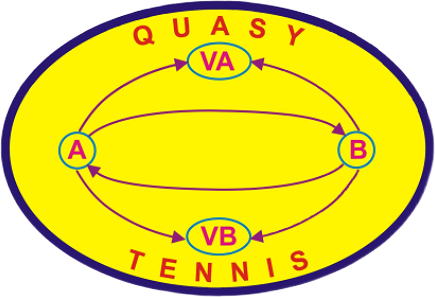Digital Avatar of a Tennis Player.
A Digital Avatar of a Tennis Player (DATP) includes gameplay parameters and Technique Element Clips (TEC). Gameplay parameters are determined by streaming coefficients such as "alpha," "beta," "gamma," and "timing." TECs contain video fragments showcasing the execution of tennis strokes in typical situational gameplay states.
About Virtual and Quasi-Virtual Tennis Players.
- Phygital tennis offers a unique opportunity for everyone to experience the game of tennis. "Phygital tennis" is just a figure of speech—a term for a new, alternative version of tennis. However, phygital tennis implies a Tennis Game System (TGS), whose distinctive feature is the unique integration of a tennis player's digital image (digital avatar or DA) and the mathematical model of the sport.
- The TGS is concretely described by three stochastic differential Kolmogorov equations. This system serves as the primary algorithm guiding the Bot Administrator (BA) in organizing and conducting virtual tournaments.
- Once registered in the phygital tennis system, enthusiasts and fans of the game automatically acquire the status of a quasi-virtual tennis player (QVT). This opens up exciting opportunities to participate in virtual tournaments. Moreover, players can enhance their DA through training on real tennis courts if they wish.
- Why "Quasi-Virtual" Tennis Player? The BA initially does not know the technical level of a QVT. This could be someone who has never held a tennis racket. Nonetheless, the BA registers the player in its database, assigning them the lowest gameplay rating.
Digital Transformation of Sports.
The digital transformation of sports is characterized by an exceptionally high social impact. This is evidenced by the widespread popularity of eSports games and numerous sports project competitions, where categories like "Transformation in Sports" feature a variety of original sports innovations.
Phygital Tennis and the Tennis Metaverse.
Phygital tennis is based on the concept of uniting randomness and determinism. The digital image of a tennis player and the model of the "Tennis" sports system form a unified stochastic representation of virtual competitions.
This operational scheme of the virtual tennis system aligns closely with the current metaverse concept, which we propose to call the "Tennis Metaverse" (TMV). In the future, the uniqueness of a tennis player’s digital image will be authenticated through NFT tokens (NFTs are unique tokens representing digital assets on blockchain networks, confirming ownership of original digital objects).
Metaverses and Their Popularity.
Metaverses have become one of the most popular concepts of the early 2020s. The combination of virtual reality and monetization has made this segment of the internet highly sought after.
For example:
- The NFT digital house "Mars House" was sold for $515,000 in March 2021.
- In November 2021, Metaverse Group, a subsidiary of Canadian investment company Tokens.com, purchased an
estate of 116 parcels in the Fashion Street district of the Decentraland metaverse for $2,000,500.
Note: Decentraland is a metaverse sandbox with an open world and broad functionality operating on the Ethereum blockchain. Users can purchase, build, utilize, and monetize virtual land parcels and items.
628
